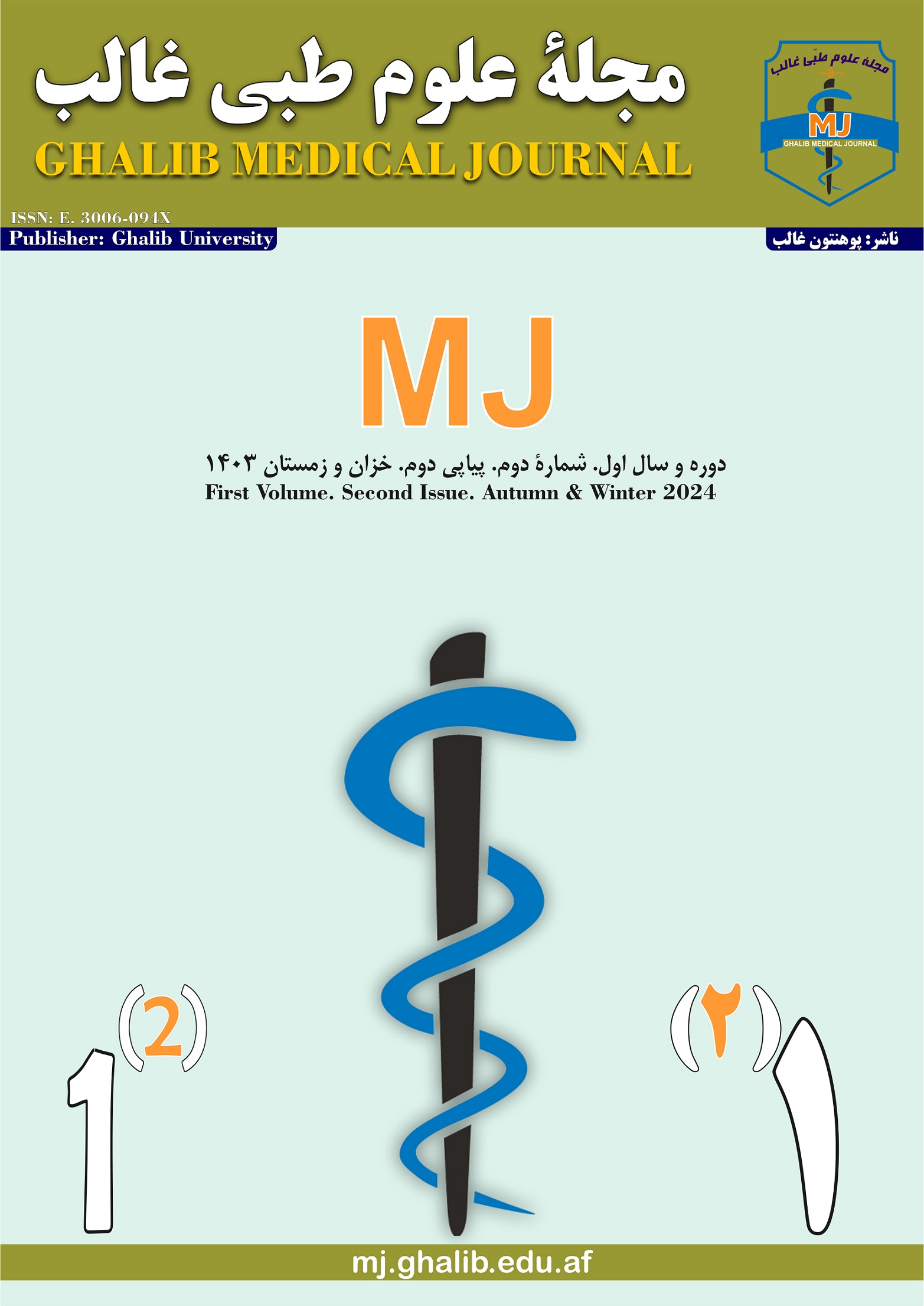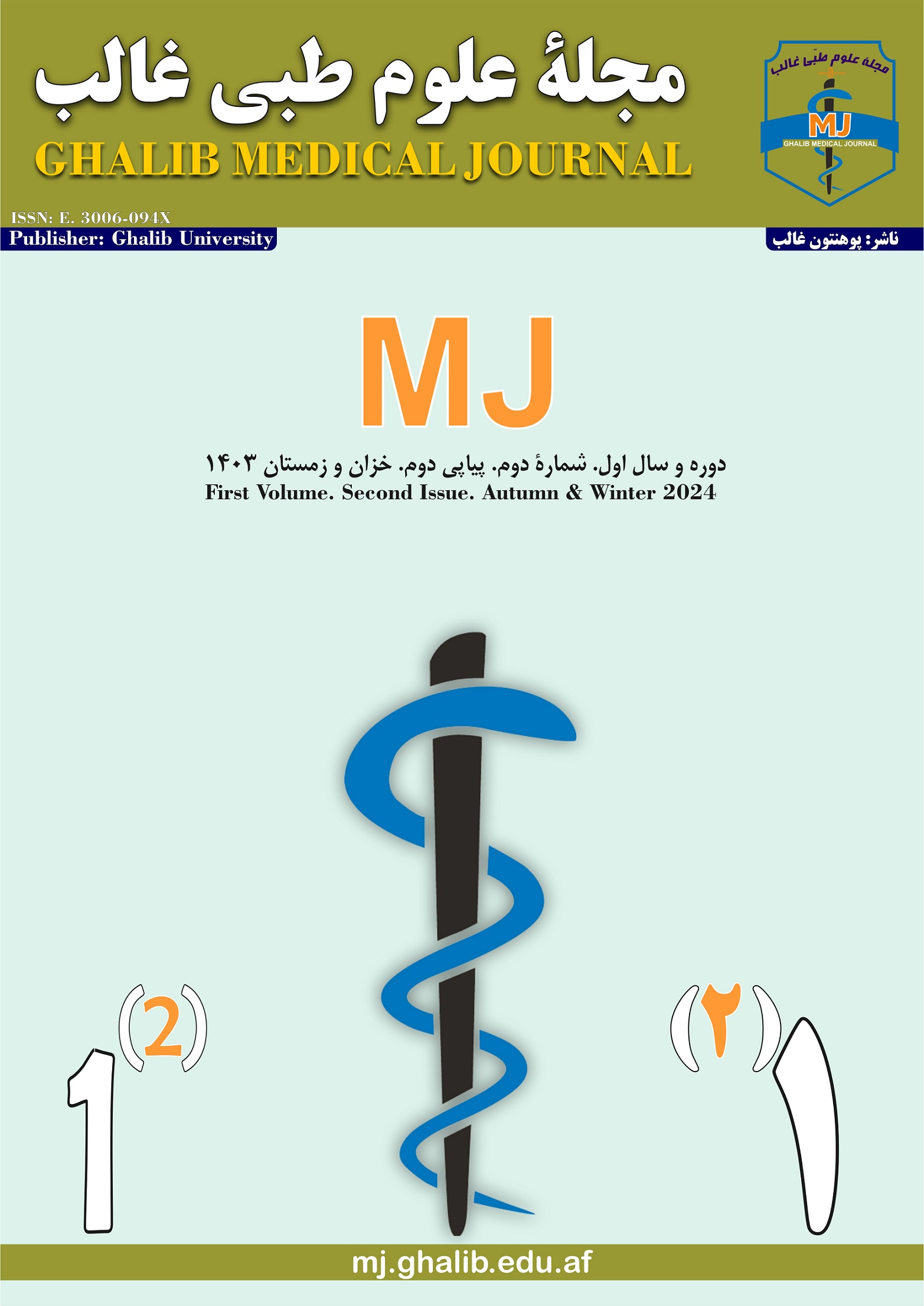The effect of greenhouse gases on the health of human skin (a case study of Herat University, Faculty of Science (
DOI:
https://doi.org/10.58342/ghalibMj.V.1.I.2.4Keywords:
Greenhouse gases, Health, Human, Fossil fuels, Carbon dioxide, Methane gasAbstract
Background: Greenhouse gases and their impact on human life represent a critical global issue due to the detrimental effects of these emissions on the environment and human health. Annually, numerous scientific conferences address global warming and strategies to reduce greenhouse gas emissions. Researchers are actively exploring renewable alternatives to fossil fuels to mitigate these adverse effects. This study investigates the impact of greenhouse gases on the skin health of citizens in Herat City.
Methods: This analytical-descriptive research involved designing a questionnaire, validated by experts, and achieving a reliability score of 0.754 using Cronbach's alpha. The questionnaire was distributed to 500 participants, including science students and their families. Data were analyzed using SPSS26 software.
Results: The findings highlight significant research potential regarding the effects of greenhouse gases on human health and life. Among the participants, 67.6% were young individuals aged 15-25 years, with 74.1% male and 25.9% female. Additionally, 53.8% of the respondents held a bachelor's degree.
Conclusion: Replacing fossil fuels with renewable energy sources is the most effective solution for reducing greenhouse gas emissions and minimizing their impact. The study revealed that consuming fruits had the most positive effect on skin health (beta coefficient = 0.20), while using moisturizers, which was less popular among participants, showed the least impact (beta coefficient = -0.291).
References
Krutmann, J. (2010). Pathomechanisms of photoaged skin. Textbook of aging skin, 101-107.
D’Amato, G., Holgate, S. T., Pawankar, R., Ledford, D. K., Cecchi, L., Al-Ahmad, M., & Annesi-Maesano, I. (2015). Meteorological conditions, climate change, new emerging factors, and asthma and related allergic disorders. A statement of the World Allergy Organization. World allergy organization journal, 8, 1-52.
Balato, N., Ayala, F., Megna, M., Balato, A., & Patruno, C. (2013). Climate change and skin. Giornale Italiano di dermatologia E venereologia: organo ufficiale, Societa italiana di dermatologia E sifilografia, 148(1), 135-146.
Bartl, K., Verones, F., & Hellweg, S. (2012). Life cycle assessment based evaluation of regional impacts from agricultural production at the Peruvian coast. Environmental science & technology, 46(18), 9872-9880.
Anderson, B., Bartlett, K. B., Frolking, S., Hayhoe, K., Jenkins, J. C., & Salas, W. A. (2010). Methane and nitrous oxide emissions from natural sources.
Manisalidis, I., Stavropoulou, E., Stavropoulos, A., & Bezirtzoglou, E. (2020). Environmental and health impacts of air pollution: a review. Frontiers in public health, 8, 14.
Cook, L. M., Riley, A. M., & Woiwod, I. P. (2002). Melanic frequencies in three species of moths in post industrial Britain. Biological Journal of the Linnean Society, 75(4), 475-482.
Ghorani-Azam, A., Riahi-Zanjani, B., & Balali-Mood, M. (2016). Effects of air pollution on human health and practical measures for prevention in Iran. Journal of research in medical sciences, 21(1), 65.
Owa, F. W. (2014). Water pollution: sources, effects, control and management. International Letters of Natural Sciences, 3.
B. Sarker, N. Keya K, I. Mahir F, M. Nahiun K, A. Khan R, Shahida S, Surface and ground water pollution causes and effects of urbanization and industrialization in south asia, Guigoz Sci Rev (73) (2021 Jul 8) 32-41.
Arif, A., Malik, M. F., Liaqat, S., Aslam, A., Mumtaz, K., Afzal, A., ... & Javed, R. (2020). Water pollution and industries. Pure and applied Biology, 9(4), 2214-2224.
Gilliom, R. J. (2007). Pesticides in US streams and groundwater.
Paul, M. J., & Meyer, J. L. (2001). Streams in the urban landscape. Annual review of Ecology and Systematics, 32(1), 333-365.
Juneja, T., & Chaudhary, A. (2013). Assessment of water quality and its effects on the health of residents of Jhunjhunu district, Rajasthan: A cross sectional study. Journal of public health and epidemiology, 5(4), 186-191.
Ali, H., Khan, E., & Ilahi, I. (2019). Environmental chemistry and ecotoxicology of hazardous heavy metals: environmental persistence, toxicity, and bioaccumulation. Journal of chemistry, 2019(1), 6730305.
Cutler, D., & Miller, G. (2005). The role of public health improvements in health advances: the twentieth-century United States. Demography, 42(1), 1-22.
Wang, Q., & Yang, Z. (2016). Industrial water pollution, water environment treatment, and health risks in China. Environmental pollution, 218, 358-365.
Juneja, T., & Chaudhary, A. (2013). Assessment of water quality and its effects on the health of residents of Jhunjhunu district, Rajasthan: A cross sectional study. Journal of public health and epidemiology, 5(4), 186-191.
Kawachi, I. (2003). Neighborhoods and health. Oxford University Press.
Honold, J., Beyer, R., Lakes, T., & van der Meer, E. (2012). Multiple environmental burdens and neighborhood-related health of city residents. Journal of environmental psychology, 32(4), 305-317.
Nakano, T., & Otsuki, T. (2013). Environmental air pollutants and the risk of cancer. Gan to kagaku ryoho. Cancer & chemotherapy, 40(11), 1441-1445.
Kampa, M., & Castanas, E. (2008). Human health effects of air pollution. Environmental pollution, 151(2), 362-367.
Andrulis, D. P. (1997). The urban health penalty: new dimensions and directions in inner-city health care. Inner city health care, 126(6), 485-490.
Downloads
Published
How to Cite
Issue
Section
License
Copyright (c) 2024 صفیالله فطرت, علیمحمد اسماعیلی, صفیالله اسلام, علیاحمد محمدی

This work is licensed under a Creative Commons Attribution 4.0 International License.










